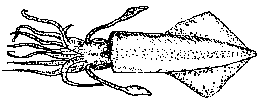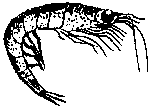|
||||||||||
BAIT
INFO
The Northern Anchovy frequents the waters of the West Coast of Vancouver Island. In the 1940's catches of Anchovy in the Strait of Georgia exceeded 5 mil. pounds annually. Anchovy grow very rapidly to 4-5 inches in their first year and at age three become sexually mature and pelagically release up to 150,000 eggs many times a year. Anchovy seldom grow over 7 inches or live beyond 6-7 years. Anchovy populations, like those of the Sandlance, could at present, be on the increase since the ocean temperatures along the coast have risen rather dramatically over the last several years.
We in the Northwest Pacific have the largest and healthiest Herring stocks in the world, some Atlantic Herring stocks, particularly those of northern Europe have been virtually annihilated.
Jack Herring (2 year old Herring, 4-6 inches)
In Winter and Spring adult Herring come together to spawn on marine vegetation in fairly shallow waters. The females will deposit some 20,000 eggs which adhere to seaweed in gelatinous masses. The male sperm (milt) is released at the same time, this often results in a condition known as "white water". After 2 weeks the embryonic Herring hatch and drift free, by late April the larval Herring are only a quarter inch in length and by late June are well over one inch. By later fall they migrate seaward where they will remain until they return as adults to repeat the life cycle in 2 to 3 years.
Pacific Herring (3-10 year old Herring, 6-15 inches)
The largest Herring that has been examined was over 15 inches in length and found to be 19 years of age (determined by microscopic reading of scale growth rings). This is an amazing fact, since the natural mortality of juvenile Herring runs over 99%, and the natural death rate of an adult Herring population is estimated to be near 50%
Sandlance or Needlefish are an elongated schooling fish that usually frequent sand bottomed areas. They also prefer waters with faster than normal tidal current flows. They frequent waters of the entire coast and at times have been found well offshore. Sandlance schooling populations begin building during spawning times, which appear to be from early spring until the fall, ranging from depths of 150 feet to the shallows of the shore. Sandlance burrow into the sand and deposit their eggs. The size of mature Sandlance can range from 4-12 inches. It is believed that during times of strong current tidal flow, 'Lance' prefer not to buck the tide, but simply bury themselves until the flow subsides.
Squid are pelagic schoolers that congregate in large schools during spawning times, and show an attraction for strong lights. Adults usually die after spawning in the later summer or fall. Squid in the 4-10 inch size generally appear in the waters of British Columbia, and can form a major part of Chinook and Coho diets. Octopus or Cuttlefish lures (4-5 inch vinyl baits) trolled behind a flasher or dodger work well on salmon feeding on squid.
Size range from microscopic to 2 cm.
| ||||||||||
|
Home | Products | Where to Find | Fishing Tips
| About Us | Email Us Copyright © 1998 - 2004 |





